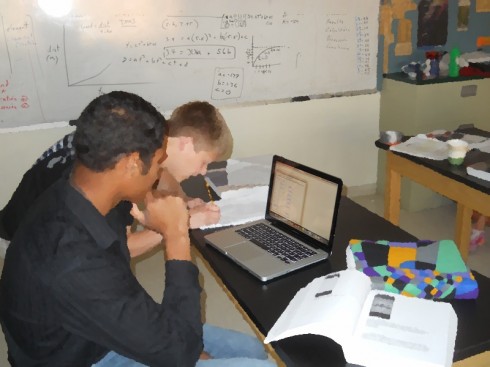One of my pre-Calculus students convinced me that the best way for him to learn how to work with matrices was for him to program a matrix solver. I helped him create a Gaussian Elimination solver in Python (which we’ve been using since last year).
Gaussian Elimination Matrix Solver by Alex Shine (comments by me).
from visual import *
'''The coefficient matrix (m) can be any sized square matrix
with an additional column for the solution'''
m = [ [1,-2,1,-4],[0,1,2,4],[2,3,-2,2]]
'''Convert the input matrix, m (which is a list) into an array'''
a = array(m,float)
print "Input matrix:"
print a
print
'''Get the shape of the matrix (number of rows and columns)'''
(r,c) = a.shape
rs = (1-r)
'''Solve'''
for j in range(r):
print "Column #:", j
for i in range(r):
if a[i,j] <> 0:
a[i,:] = a[i,:] / a[i,j]
print a
print
for i in range(rs+j,j):
if a[i,j] <> 0:
a[i,:] = a[j,:] - a[i,:]
print a
print
print "Solution"
for i in range (r):
a[i,:] = a[i,:] / a[i,i]
print "Variable", i, "=", a[i,-1]
print
print "Solution Matrix:"
print a
The code above solves the following system of equations:
x - 2y + z = -4
y + 2z = 4
2x + 3y - 2z = 2
Which can be written in matrix form as such:
![Rendered by QuickLaTeX.com \left[ \begin{array}{ccc} 1 & -2 & 1 \\ 0 & 1 & 2 \\ 2 & 3 & -2 \end{array} \right] \left[ \begin{array}{c} x \\ y \\ z \end{array} \right] = \left[ \begin{array}{c} -4 \\ 4 \\ 2 \end{array} \right]](https://MontessoriMuddle.org/wp-content/ql-cache/quicklatex.com-d7c93a4faec058d3b5dda1831bdeaca7_l3.png)
You use the solver by taking the square matrix on the left hand side of the equation and combining it with the column on the hand side as an additional column:
![Rendered by QuickLaTeX.com \left[ \begin{array}{cccc} 1 & -2 & 1 & -4 \\ 0 & 1 & 2 & 4\\ 2 & 3 & -2 & 2\end{array} \right]](https://MontessoriMuddle.org/wp-content/ql-cache/quicklatex.com-d2316bca341c565fbeab22075f4e2d73_l3.png)
This is entered into the program as the line:
m = [ [1,-2,1,-4],[0,1,2,4],[2,3,-2,2]]
When you run the above program you should get the results:
>>> ================================ RESTART ================================ >>> Input matrix: [[ 1. -2. 1. -4.] [ 0. 1. 2. 4.] [ 2. 3. -2. 2.]] Column #: 0 [[ 1. -2. 1. -4. ] [ 0. 1. 2. 4. ] [ 1. 1.5 -1. 1. ]] [[ 1. -2. 1. -4. ] [ 0. 1. 2. 4. ] [ 0. -3.5 2. -5. ]] Column #: 1 [[-0.5 1. -0.5 2. ] [ 0. 1. 2. 4. ] [-0. 1. -0.57142857 1.42857143]] [[ 0.5 0. 2.5 2. ] [ 0. 1. 2. 4. ] [ 0. 0. 2.57142857 2.57142857]] Column #: 2 [[ 0.2 0. 1. 0.8] [ 0. 0.5 1. 2. ] [ 0. 0. 1. 1. ]] [[-0.2 0. 0. 0.2] [ 0. -0.5 0. -1. ] [ 0. 0. 1. 1. ]] Solution Variable 0 = -1.0 Variable 1 = 2.0 Variable 2 = 1.0 Solution Matrix: [[ 1. -0. -0. -1.] [-0. 1. -0. 2.] [ 0. 0. 1. 1.]] >>>
Be aware that:
- The code is designed to take any size of matrix.
- The matrix you put in can not have any zeros on its diagonal, so some manipulation is often necessary before you can use the code.
Other notes:
- The negative zeros (-0) that show up especially in the solution matrix may not look pretty but do not affect the solution.
- The code imports the vpython module in the first line but what it really needs is the numpy module, which vpython imports, for the arrays.
The next step is to turn this into a function or a class that can be used in other codes, but it’s already proved useful. My calculus students compared their solutions for the coefficients of a quadratic equation that they had to solve for their carpet friction experiment, which was great because their first answers were wrong.






